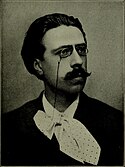Paul Gilson
 | |
| Data i miejsce urodzenia | 15 czerwca 1865 Bruksela |
|---|---|
| Pochodzenie | belgijskie |
| Data i miejsce śmierci | 3 kwietnia 1942 Bruksela |
| Gatunki | muzyka poważna, muzyka romantyczna |
| Zawód | kompozytor, pedagog |
Paul Gilson (ur. 15 czerwca 1865 w Brukseli, zm. 3 kwietnia 1942 tamże)[1] – belgijski kompozytor i pedagog okresu romantyzmu.
Życiorys
Gilson dzieciństwo spędził w podbrukselskiej wsi Ruysbroeck. Tam, u miejscowego organisty, zdobywał podstawy wiedzy muzycznej. Uczył go również dyrektor szkoły muzycznej w Anderlechcie nazwiskiem Duyck. W latach 1886–1889 studiował w Brukseli kompozycję u François Auguste'a Gevaerta. W 1889 r. otrzymał Prix de Rome za kantatę Sinaī. Rozgłos przyniosło mu wykonanie szkiców symfonicznych Le mer. Utwór ten z powodzeniem wykonywano w Londynie, Paryżu, Petersburgu i w wielu miastach Niemiec. Sławę Gilsona ugruntowało oratorium Francesca da Rimini, wykonane w 1895 r. w Brukseli. Po tych wydarzeniach, w latach 1899–1909 był wykładowcą harmonii w konserwatorium muzycznym w rodzinnym mieście, a w latach 1904–1909 także w Antwerpii. W 1909 r. otrzymał posadę inspektora szkół muzycznych we flamandzkiej części Belgii. Zajmował się krytyką muzyczną na łamach Le Soir i Diapason. Był również redaktorem muzycznym pisma Midi. W 1924 r. wspólnie z Marcelem Pootem założył La Revue musicale belge. Patronował, powstałej rok później, grupie flamandzkich i walońskich kompozytorów Les Sunthétistes, której niemal wszyscy członkowie byli jego uczniami[1].
Twórczość
Na przełomie XIX i XX w. Gilson wysunął się na czoło współczesnych mu belgijskich kompozytorów. Był przede wszystkim symfonikiem. Jego styl kształtował się pod wpływem późnoromantycznej muzyki niemieckiej (zwłaszcza Wagnera). Z drugiej strony Paul Gilson jako jeden z pierwszych kompozytorów zachodnioeuropejskich umiał docenić stylistykę rosyjskiej szkoły narodowej. Propagował tę muzykę i przyswoił sobie niektóre środki stylistyczne członków Potężnej Gromadki. Przejął od nich m.in. skłonności orientalne i barwną instrumentację. To stylistyczne pokrewieństwo łatwo spostrzec w La mer. Ta czteroczęściowa symfonia programowa wyniosła muzykę belgijską na poziom europejski. W pierwszym dziesięcioleciu XX w. rozwój twórczości Gilsona uległ zahamowaniu. Nie wywarły na niego wpływu nowe koncepcje stylistyczne Debussy’ego czy Strawinskiego. Jednak sam Paul Gilson wywarł ogromny wpływ na rozwój belgijskiej muzyki nie tylko jako kompozytor, ale wychowawca dwóch pokoleń kompozytorów[1].
Przypisy
- ↑ a b c Pisarenko 1987 ↓, s. 307-308.
Bibliografia
- Olgierd Pisarenko: Gilson Paul. W: Encyklopedia muzyczna PWM. Elżbieta Dziębowska (red.). Wyd. I. T. 3: EFG część biograficzna. Kraków: PWM, 1987. ISBN 83-224-0344-5. (pol.)
Linki zewnętrzne
- Paul Gilson w AllMusic (ang.)
Media użyte na tej stronie
Autor: Internet Archive Book Images, Licencja: No restrictions
Paul Gilson
Identifier: moderncomposerso00elso (find matches)
Title: Modern composers of Europe : being an account of the most recent musical progress in the various European nations, with some notes on their history, and critical and biographical sketches of the contemporary musical leaders in each country
Year: 1905 (1900s)
Authors: Elson, Arthur, 1873-1940
Subjects: Composers
Publisher: Boston : L.C. Page
Contributing Library: Harold B. Lee Library
Digitizing Sponsor: Brigham Young University
View Book Page: Book Viewer
About This Book: Catalog Entry
View All Images: All Images From Book
Click here to view book online to see this illustration in context in a browseable online version of this book.
Text Appearing Before Image:
tasie on the melodies of Canada, anotheron those of Ireland, half a dozen suites, the sym-phonic sketches entitled La Mer, the Bucolics,after Virgil, three scherzi, a festival march, a fan-fare march, and many shorter pieces. His choralworks include an Inaugural Cantata, a cantata forthe fiftieth anniversary of the Belgian telegraph,the oratorio Moses, the dramatic oratorio Francesca da Rimini, and several sets of acapella works. He has also made some interestingexcursions into the field of declamation with or-chestra, such as Le Feu du Ciel (Hugo),Christine (Leconte de Lisle), and the Japanesefable Satsuki. His operas include Les PauvresGens, Frinses Zonnenschijn, Les A ventu-rers, and Le Demon, as well as incidentalmusic to the dramas Alvar and Liefdeblaem.Of these many works the one best known inAmerica is La Mer, which has been given sev-eral times in symphony concerts. It was suggestedby a poem of Ed. Levis, which is frequently readbefore the performance. The first movement gives
Text Appearing After Image:
PAUL GILSON. THE NETHERLANDS 189 an excellent picture of sunrise at sea, with all themany-coloured splendours of the dawn. Then fol-lows some rollicking sailors music, in which theirlively songs and dances are suggested with dueanimation. The third movement portrays a love-scene between the sailor and his sweetheart, idyllicat first, but ending in sadness as he must embarkand she gives way to fear of the treacherous ocean.The finale depicts the tempest, and the sailorschoruses are introduced in mocking irony as theship goes down. Through it all runs a vein ofpoetic fancy, exquisitely suggesting the beauty andmystery of the sea. Francesca da Rimini is another powerfulwork. It opens in the realm of shades, where theguilty lovers find themselves after death. They arebrought before the judge Minos, and Paolo tellstheir story. The demons cry for vengeance on thecouple, and Paolo* tries to save Francesca, but theyare condemned. The next scene shows them, aspictured by Dante, floating about
Note About Images
